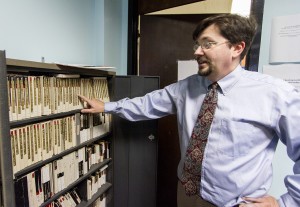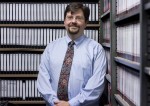Several dozen rows of tape recordings filled with decades-old television news history occupy a classroom on the fourth floor of the UCLA Luskin School of Public Affairs building. A few miles away, a UCLA special collections library stores textual manuscripts dating back to the 17th century.
UCLA professors are digitizing collections of books and videotape recordings to make their information accessible online in an era of growing technology use. Communication studies faculty are digitizing tape recordings to preserve them for future generations, while librarians seek to use digitization to publicize their manuscripts.
The William Andrews Clark Memorial Library at UCLA, which houses rare English literature manuscripts, recently received a $194,000 grant from the Council on Library and Information Resources, or CLIR, to scan 300 bound manuscripts from the 17th and 18th centuries. The grant will pay Luna Imaging, a scanning company, to prepare, ship and digitize the manuscripts.
Nancy Shawcross, principal investigator of the project and academic administrator for Clark Library, said the library’s goal is to make them available to the public by scanning and uploading them onto UCLA’s digital library website.
Shawcross said she does not think providing access to library materials online will dissuade people from visiting libraries.
“When it comes to manuscripts and unique materials, digitization will lead to more use, not less,” Shawcross said. “Digitization is a great window to the material, but you always need the originals as proof of exactly what you have.”

Philip Palmer, co-principal investigator of the project and CLIR postdoctoral fellow in data curation for early modern studies at Clark Library, said he thinks physical manuscripts will outlast digital content. He added digital file formats quickly become lost or obsolete, but physical manuscripts can last for centuries if properly stored.
Palmer said special collections libraries were exclusive to scholars in previous years, but can now be made more accessible through digitization. He added he will work with three graduate students to digitally transcribe annotations from about seven 17th to 18th century manuscripts this summer. Palmer said he thinks the experience will help the students become more competitive in the job market.
“Increasingly, jobs in the humanities are asking for job candidates to have experience in digital methods, for what’s called the digital humanities,” Palmer said. “We see this as a positive for us and for the students’ professional development.”
Ellen Truxaw, an English graduate student, has also worked in the digital humanities field. Truxaw is the graduate lead researcher of a project that aims to scan the cover art of 19th century Victorian novels and share them online.
Members of the project have scanned covers from hundreds of these books, called yellowbacks because they were often bound in yellow boards, and uploaded the images to a Flickr account. In October 2015, a group of English graduate students generated interest for the account through crowd-sourcing, or actively tagging the images with relevant descriptions to make them easier to find.
Truxaw plans to host an exhibit at the UCLA Charles E. Young Research Library called “Crowd-Sourcing the Graphic Covers of Victorian Crowd-Pleasers” later this month to display these novels.
Jonathan Grossman, the project’s team leader and English professor, said the project’s use of crowdsourcing to promote yellowback novels shows how technology allows libraries to make their collections digitally accessible to the public. He added their main goal is to promote the collection rather than to store the material using digital files.
“I worry about the internet as an archival tool, but I see it as a way to get things out to people,” Grossman said.
Tim Groeling, professor and chair of the communication studies department, is digitizing a collection of thousands of hours of audio recordings and television shows stored on videotapes.
Audio and videotapes will last no longer than a few more years, unlike library manuscripts, Groeling said. The tapes will eventually become unreadable if they are not reformatted and uploaded online, he added.
The recordings, stored on the magnetic strips of videotapes originally recorded on VCR’s, become less readable every year because the magnetic strip can be easily damaged. If the department waits too long, they run the risk of losing these recordings forever, Groeling said.
“We have some problems with this material degrading and even at this point some of our tapes are not viewable,” Groeling said. “We have all this material and it’s on a format that’s obsolete so we have to transfer it off.”
Groeling said he wants to preserve important 20th century political history and new avenues of research within communication studies. He said one of these research opportunities includes examining the gestures of politicians on TV shows to detect patterns of communication.
“It’s like getting sight after being blind,” Groeling said. “Digitization allows us to preserve the material we would have otherwise lost.”
Groeling said he has already digitized recordings of campus speeches from the ’60s and ’70s, which can be found on the communication studies department’s YouTube channel, but he is still working toward digitizing 150,000 hours of TV show recordings to add to UCLA’s growing online collection.
Shawcross said she thinks the popularity of digitizing old materials is increasing among librarians and faculty members, among others.
“Digitizing some of our material allows students and scholars the access they may not be able to get if they can’t travel to the library,” Shawcross said. “What we see is an ability to share our resources worldwide.”
